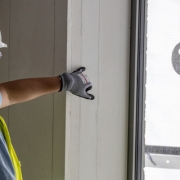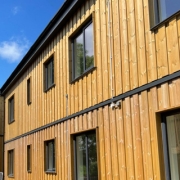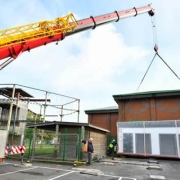Designed by Fletcher Priest Architects and now under construction in the City of London, the 94,000 sq ft Edenica office development at 100 Fetter Lane is on track to set a “significant” sustainability precedent for UK commercial buildings, Waterman says.
Sustainability consultancy company, Waterman says this scheme for BauMont Real Estate Capital and YardNine is harnessing the latest design techniques to optimise operational energy efficiency and slash embodied carbon.
As part of the development’s “unique” approach to cutting whole-life carbon and creating a robust platform for material circularity, Waterman says its Sustainability Team is pioneering the use of Materials Passports on the project.
Waterman describes Materials Passports as digital data sets which describe characteristics of materials and components in products and systems, giving them “value for present use, recovery and future reuse”.
Our philosophy when it comes to development and refurbishment projects is to take a ‘use less, waste less’ approach.
Edenica will act as a pilot project for their implementation and is the first scheme within the City of London to be designed as a storage bank where materials are held for future reuse, the sustainability consultancy company says.
Working alongside the project manager, Third London Wall, Waterman says its Sustainability team has set out the pathway for procurement to ensure the Materials Passports contain key characteristics of selected building materials held in a centralised database.
This can be used to provide reports on maintenance and potential future reuse over the life of the building and beyond, maximising both material life and whole life value, Waterman says.
Just as a regular passport provides personal details of an individual’s identity, Waterman says Edenica’s Materials Passports will become a snapshot of the building elements’ credentials, providing records of the materials, products, and components that have been used.
The company says that the records will enable the reuse of materials during the building’s operation or at the end of its life, turning the used materials into valuable resources instead of waste.
The scheme’s Materials Passports will facilitate the reuse of materials in the coming years by future owners, design teams, manufacturers and contractors, Waterman says.
It is hugely important that we continually try to advance and innovate to help tackle the climate emergency
BauMont Real Estate Capital’s Managing Director, Natalie Harrison, said: “Our philosophy when it comes to development and refurbishment projects is to take a ‘use less, waste less’ approach.
“We engage sustainability specialists at the outset of our projects to ensure our desire to deliver buildings with best-in-class ESG credentials is taken into account in the early stages of design.
“This leads to better collaboration and promotes innovation, a good example of this being Waterman’s Material Passports initiative being delivered at Edenica, which looks beyond policy, setting a new precedent for London.”
Waterman’s Sustainability Associate, Anastasia Stella, who led the development of Materials Passports at Edenica, said: “It is hugely important that, as construction professionals, we continually try to advance and innovate to help tackle the climate emergency.
“Our Materials Passport initiative shows how even the simplest of concepts can create the potential for a significant reduction in whole-life carbon and optimise re-purposing of materials in the future.”
Source: Circular Online
 Many building materials, such as concrete, have an element of natural resistance to fire. However, in the event of a fire, exposed concrete can experience both mechanical and chemical changes such as explosive spalling and external cracking, both of which can cause it to progressively lose its strength, resulting in potential structural failure.
Many building materials, such as concrete, have an element of natural resistance to fire. However, in the event of a fire, exposed concrete can experience both mechanical and chemical changes such as explosive spalling and external cracking, both of which can cause it to progressively lose its strength, resulting in potential structural failure.








